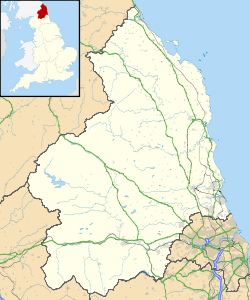- Otterburn Hall
-
Otterburn Hall 
General information Architectural style Neo-Elizabethan style Location Near Otterburn, Northumberland, England Coordinates 55°14′35″N 2°11′4″W / 55.24306°N 2.18444°WCoordinates: 55°14′35″N 2°11′4″W / 55.24306°N 2.18444°W Current tenants Hotel Completed 1086
1830Technical details Structural system Brick with stone Website Official site Otterburn Hall is a AA four-star fortified English country house and estate, now used as a hotel, in Otterburn, Northumberland. It is situated in 500 acres (200 ha) of deer park and woodland in the Northumberland National Park, northeastern England. The building was constructed in 1870 for Lord James Douglas, the land given to him as recompense for the death of Lord James Douglas, who fought at the Battle of Otterburn, and was killed near Otterburn Tower (originally a castle), itself founded in 1086, and rebuilt in 1830. Both Otterburn Hall and Otterburn Castle have been seats of landed gentry.[1]
Contents
Geography
The English country house is situated in the Redesdale valley in a rural national park. It is north of Otterburn in Northumberland, and 25 miles (40 km) northwest of Cramlington.[2][3] The hall's estate encompasses an area of 500 acres (200 ha) of deer park and woodland. An 8 miles (13 km) stretch of the River Rede flows close to the estate.[4][5] There are several historical buildings nearby, including Otterburn Church, built in 1857; Otterburn Tower, a Grade II listed castellated mansion built in 1830 at the site of a medieval tower whose vestiges no longer remain;[6] and Otterburn Mill, which dates to the 1800s.
History
An older Otterburn Hall existed at least as early as 1777. At that time, the Hugh Percy, 2nd Duke of Northumberland asked the hall's owner, Henry Ellison, for permission to erect a monument on the field to honor his ancestor who died during the Battle of Otterburn. Ellison denied the request and raised a monument himself which included an obelisk, possibly an architrave removed from Otterburn Hall's kitchen fireplace, which was placed into a socketed battle stone.[7]
The present building was constructed in 1870 for Lord James Douglas on land gifted as recompense for the death of his ancestor, Lord Douglas, who fought at the Battle of Otterburn.[6] Stables, lodges, and a farm were part of the 19th century complex.[8] By 1907, Sir Charles Morrrison-Bell, 1st Bart. was of Otterburn Hall.[9] During World War II, from 1940 to 1944, the hotel was used as a military hospital. The Otterburn Training Area, established in 1911 and owned by the Ministry of Defence, is nearby and is the second largest live firing range in the country.[10] In 1948, it was acquired by a group of Christian business men who wanted to start a new venture in Christian education.[11] By 1980, the building was converted into a hotel.[8]
Architecture and fittings
The building, in Neo-Elizabethan style, is constructed of brick with stone dressings. Renovation occurred in 1905 for Sir Charles Morrison Bell including the addition of a porch which accentuates the facade of the hall. Another renovation occurred in 1930 subsequent to a fire. A large conservatory is located in the rear of the building.[6][8] The hall has had its own landing ground since the early 1930s.[2][3] Otterburn Hall contains 65 rooms and a restaurant.
References
- ^ Bartholomew, John George (1904). The survey gazetteer of the British Isles, topographical, statistical, and commercial: compiled from the 1901 census and the latest official returns. Newnes. pp. 619–. http://books.google.com/books?id=kSYOAQAAMAAJ&pg=PA619. Retrieved 16 July 2011.
- ^ a b Royal Aero Club of the United Kingdom; United Service and Royal Aero Club (July 1933). Flight International. IPC Transport Press Ltd.. p. 783. http://books.google.com/books?id=bXEPAAAAIAAJ. Retrieved 4 July 2011.
- ^ a b Burke, Thomas (1933). The beauty of England. G. G. Harrap. p. 305. http://books.google.com/books?id=lNEBAAAAMAAJ. Retrieved 4 July 2011.
- ^ "Otterburn Hall, Otterburn (Northumberland)". historicbritain.com. http://www.historicbritain.com/vendor/otterburnhall.aspx. Retrieved 6 July 2011.
- ^ "Otterburn Hall Hotel". Gardenvisit.com. http://www.gardenvisit.com/hotel/otterburn_hall_hotel. Retrieved 6 July 2011.
- ^ a b c Pevsner, Nikolaus; Grundy, John; McCombie, Grace; Peter Ryder, Humphrey Welfare (11 March 1992). Northumberland. Yale University Press. pp. 537–. ISBN 9780300096385. http://books.google.com/books?id=kClO7NOfvsIC&pg=PA537. Retrieved 5 July 2011.
- ^ Goodman, Anthony; Tuck, Anthony (1992). War and border societies in the middle ages. Psychology Press. pp. 77–. ISBN 9780415080217. http://books.google.com/books?id=8FG5hYdPzRsC&pg=PA77. Retrieved 16 July 2011.
- ^ a b c Paul Frodsham; Council for British Archaeology (2004). Archaeology in Northumberland National Park. Council for British Archaeology. p. 122. ISBN 9781902771380. http://books.google.com/books?id=SuRvAAAAIAAJ. Retrieved 6 July 2011.
- ^ Addison, Henry Robert; Oakes, Charles Henry; Lawson, William John; Douglas Brooke Wheelton Sladen (1907). Who's who. A. & C. Black. pp. 1511–. http://books.google.com/books?id=yEcuAAAAYAAJ&pg=PA1511. Retrieved 16 July 2011.
- ^ "Otterburn Training Area". Ministry of Defence. http://www.mod.uk/DefenceInternet/MicroSite/DIO/WhatWeDo/DTE/OtterburnTrainingArea.htm. Retrieved 6 July 2011.
- ^ "Spectator". The Spectator 180: 89. 1948. http://books.google.com/books?id=NYNHAQAAIAAJ&q=%22otterburn+hall%22&dq=%22otterburn+hall%22&hl=en&ei=jLkhTq9M6ebRAfK84c4D&sa=X&oi=book_result&ct=result&resnum=1&ved=0CC0Q6AEwADgK.
External links
Categories:- Country houses in Northumberland
- Hotels in Northumberland
- Houses completed in 1870
- Otterburn, Northumberland
Wikimedia Foundation. 2010.

